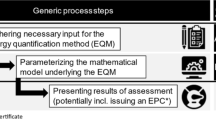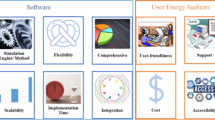Abstract
Energy audit is a standardized and well-accepted process, consisting of inspection, survey, assessment, and evaluation of residential properties, commercial establishments and industrial plants, using sophisticated instruments as well as human experts. Energy audit of a city consists of inspections of many thousands (or even hundreds of thousands) of properties of varied ages, types, sizes, conditions, occupancy, and usage patterns. In this paper, we demonstrate how data envelopment analysis (DEA) techniques can be used to derive useful insights from energy audit data of a city, as compared to regression-based or anomaly detection based approaches. We also show how DEA can be used to come up with recommendations for reducing energy consumption. We illustrate the approach by analyzing energy audit data of Austin, Texas.
Access this chapter
Tax calculation will be finalised at checkout
Purchases are for personal use only
Similar content being viewed by others
References
Krarti, M.: Energy Audit of Building Systems: An Engineering Approach. CRC Press, Boca Raton (2000)
Thumann, A.: Handbook of Energy Audits, 9th edn. The Fairmont Press, Lilburn (2012)
Mardani, A., Zavadskas, E.K., Streimikiene, D., Jusoh, A., Khoshnoudi, M.: A comprehensive review of data envelopment analysis (DEA) approach in energy efficiency. Renew. Sustain. Energy Rev. 70, 1298–1322 (2017)
Xu, T., You, J., Li, H., Shao, L.: Energy efficiency evaluation based on data envelopment analysis: a literature review. Energies 13(3548) (2020)
Arens, A.A., Loebbecke, J.K.: Auditing: An Integrated Approach, 8th edn. Pearson, London (1999)
Dickey, G., Blanke, S., Seaton, L.: Machine learning in auditing: current and future applications. CPA J. 89(6), 16–21 (2019)
Bowling, S., Meyer, C.: How we successfully implemented AI in audit. J. Account. 227(5), 26–28 (2019)
Kokina, J., Davenport, T.H.: The emergence of artificial intelligence: how automation is changing auditing. J. Emerg. Technol. Account. 14(1), 115–122 (2017)
Issa, H., Sun, T., Vasarhelyi, M.A.: Research ideas for artificial intelligence in auditing: the formalization of audit and workforce supplementation. J. Emerg. Technol. Account. 13(2), 1–20 (2016)
Brown-Liburd, H., Issa, H., Lombardi, D.: Behavioral implications of big data’s impact on audit judgment and decision making and future research directions. Account. Horiz. 29(2), 451–468 (2015)
Earley, C.E.: Data Analytics in Auditing: Opportunities and Challenges, vol. 58 (2015)
Issa, H., Kogan, A.: A predictive ordered logistic regression model as a tool for quality review of control risk assessments. J. Inf. Syst. 28(2), 209–229 (2014)
Hunton, J.E., Rose, J.M.: 21st-century auditing: advancing decision support systems to achieve continuous auditing. Account. Horiz. 24(2), 297–312 (2010)
Omoteso, K., Patel, A., Scott, P.: Information and communications technology and auditing: current implications and future directions. Int. J. Audit. 14(2), 147–162 (2010)
Etheridge, H.L., Sriram, R.S., Hsu, H.K.: A comparison of selected artificial neural networks that help auditors evaluate client financial viability. Decis. Sci. 31(2), 531–550 (2000)
Asarhelyi, M.A.: Artificial intelligence in accounting and auditing: the use of expert systems (1989)
Seyedzadeh, S., Rahimian, F.P., Glesk, I., Roper, M.: Machine learning for estimation of building energy consumption and performance: a review. Visual. Eng. 6(1), 1–20 (2018)
Beccali, M., Ciulla, G., Brano, V.L., Galatioto, A., Bonomolo, M.: Artificial neural network decision support tool for assessment of the energy performance and the refurbishment actions for the non-residential building stock in southern Italy. Energy 137, 1201–1218 (2017)
Lara, R.A., Pernigotto, G., Cappelletti, F., Romagnoni, P., Gasparella, A.: Energy audit of schools by means of cluster analysis. Energy Build. 95, 160–171 (2015)
Marasco, D.E., Kontokosta, C.E.: Applications of machine learning methods to identifying and predicting building retrofit opportunities. Energy Build. 128, 431–441 (2016)
Guo, X.-D., Zhu, L., Fan, Y., Xie, B.-C.: Evaluation of potential reductions in carbon emissions in Chinese Provinces based on environmental DEA. Energy Policy 39(5), 2352–2360 (2011)
Picazo-Tadeo, A.J., Beltrán-Esteve, M., Gómez-Limón, J.A.: Assessing eco-efficiency with directional distance functions. Eur. J. Oper. Res. 220(3), 798–809 (2012)
Zhou, P., Ang, B.W., Han, J.Y.: Total factor carbon emission performance: a Malmquist index analysis. Energy Econ. 32(1), 194–201 (2010)
Hu, J.-L., Kao, C.-H.: Efficient energy-saving targets for APEC economies. Energy Policy 35(1), 373–382 (2007)
Song, M., An, Q., Zhang, W., Wang, Z., Jie, W.: Environmental efficiency evaluation based on data envelopment analysis: a review. Renew. Sustain. Energy Rev. 16(7), 4465–4469 (2012)
Hu, J.-L., Wang, S.-C.: Total-factor energy efficiency of regions in China. Energy Policy 34(17), 3206–3217 (2006)
He, P., Sun, Y., Shen, H., Jian, J., Zhongfu, Y.: Does environmental tax affect energy efficiency? An empirical study of energy efficiency in OECD countries based on DEA and logit model. Sustainability 11(14), 3792 (2019)
Liu, Y., Wang, K.: Energy efficiency of China’s industry sector: an adjusted network DEA (data envelopment analysis)-based decomposition analysis. Energy 93, 1328–1337 (2015)
Färe, R., Grosskopf, S., Lindgren, B., Roos, P.: Productivity developments in Swedish hospitals: a Malmquist output index approach. In: Charnes, W.W.C., Lewin, A.Y., Seiford, L.M. (eds.) Data Envelopment Analysis: Theory, Methodology, and Applications, pp. 253–272. Springer, Dordrecht (1994). https://doi.org/10.1007/978-94-011-0637-5_13
Rhodes, J.D., Stephens, B., Webber, M.E.: Using energy audits to investigate the impacts of common air-conditioning design and installation issues on peak power demand and energy consumption in Austin, Texas. Energy Build. 43(11), 3271–3278 (2011)
Rhodes, J., Stephens, B., Webber, M.E.: Energy audit analysis of residential air-conditioning systems in Austin, Texas. ASHRAE Trans. 118(1) (2012)
Aparicio, J.: A survey on measuring efficiency through the determination of the least distance in data envelopment analysis. J. Centrum Cathedra (2016)
Bogetoft, P., Otto, L.: Benchmarking with DEA, SFA, and R, vol. 157. Springer, New York (2010). https://doi.org/10.1007/978-1-4419-7961-2
Tone, K.: A slacks-based measure of efficiency in data envelopment analysis. Eur. J. Oper. Res. 130(3), 498–509 (2001)
Amirteimoori, A., Kordrostami, S.: A Euclidean distance-based measure of efficiency in data envelopment analysis. Optimization 59(7), 985–996 (2010)
Charnes, A., Cooper, W.W., Rhodes, E.: Measuring the efficiency of decision making units. Eur. J. Oper. Res. 2(6), 429–444 (1978)
Cooper, W.W., Seiford, L.M., Tone, K.: Data Envelopment Analysis, 2nd edn. Springer, Boston (2007). https://doi.org/10.1007/b109347
Zhao, Y., Nasrullah, Z., Li, Z.: PyOD: a Python toolbox for scalable outlier detection. J. Mach. Learn. Res. 20(96), 1–7 (2019)
Author information
Authors and Affiliations
Corresponding author
Editor information
Editors and Affiliations
Rights and permissions
Copyright information
© 2021 Springer Nature Switzerland AG
About this paper
Cite this paper
Vaishampayan, S., Pawde, A., Shinde, A., Apte, M., Palshikar, G.K. (2021). Data Envelopment Analysis for Energy Audits of Housing Properties. In: Kamp, M., et al. Machine Learning and Principles and Practice of Knowledge Discovery in Databases. ECML PKDD 2021. Communications in Computer and Information Science, vol 1525. Springer, Cham. https://doi.org/10.1007/978-3-030-93733-1_40
Download citation
DOI: https://doi.org/10.1007/978-3-030-93733-1_40
Published:
Publisher Name: Springer, Cham
Print ISBN: 978-3-030-93732-4
Online ISBN: 978-3-030-93733-1
eBook Packages: Computer ScienceComputer Science (R0)




